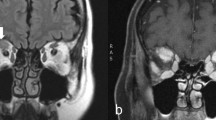Abstract
Objective: The aim of this study was to clarify whether Tc-99m HIG (Polyclonal Human Immunoglobulin G) can image and determine the severity of orbital involvement in patients with Graves’ ophthalmopathy.Materials and Methods: Twenty-six patients between 19 and 56 years old with Graves’ ophthalmopathy were examined. All patients received approximately 370 MBq Tc-99m HIG by i.v. injection. Planar and SPECT examination were performed 4 hours after the injection. Visual and semiquantitative evaluations were performed for both orbits by two independent observers,Results: Clinically active ophthalmopathy patients had noticeably increased orbital accumulation of Tc-99m HIG. In patients with inactive disease, and 14 of 19 had no uptake, whereas 5 patients had orbital radioactivity accumulation. The duration of Graves’ ophthalmopathy did not correlate with the presence of active ophthalmopathy and Tc-99m HIG grade. There was a good correlation between clinical classification and clinical activity (r=278). There was a good correlation between clinical activity and the radioactivity grade with r=0.666 (p=0.01). The clinical classification closely correlated with Tc-99m HIG grade (r=0.423, p=0.05).Conclusion: Tc-99m HIG scan can clearly identified clinically active patients, and subclinicial inflammation can be shown by this scintigraphic evaluation. The current preliminary results suggested that Tc-99m HIG SPECT might be useful for the assessment of disease activity in Graves’ ophthalmopathy.
Similar content being viewed by others
References
Burch HB, Wartofsky L. Graves’ ophthalmopathy: current concepts regarding pathogenesis and management.Endocrin Rev 1993; 14: 747–793.
Perros P, Kendall-Taylor P. Natural history of eye disease.Thyroid 1998; 8: 423–425.
Jacobson DH, Gorman CA. Diagnosis and management of endocrine ophthalmopathy: current ideas concerning etiology, pathogenesis, and treatment.Endocrin Rev 1984; 5: 200–220.
Feldon SE, Muramatsu S, Wiener JM. Clinical classification of Graves’ ophthalmopathy: Identification of risk factors for optic neuropathy.Arch Ophthalmol 1984; 102: 1469–1472.
Hales IB, Rundle FF. Ocular changes in Graves’ disease. A long-term follow-up study.Quarterly J Med 1960; 29: 113–126.
Jakobiec FA, Font RL. Orbit. In: Spencer WH (ed),Ophthalmic Pathology, Vol. 3, 3rd ed. Philadelphia; WB Saunders, 1986.
Wall JR, Salvi M, Bernard NF, Boucher A, Haegert D. Thyroid associated ophthalmopathy: a model for the association of organ-specific autoimmune disorders.Immunol Today 1991; 12: 150–153.
Dresner SC, Kennerdell JS. Dysthyroid orbitopathy.Neurology 1985; 35: 1628–1634.
Feldon SE. Diagnostic tests and clinical techniques in the evaluation of Graves’ ophthalmopathy. In: Wall JR, How J (eds),Graves’ Ophthalmopathy. Boston; Blackwell Scientific, 1990: 79–93.
Mourits M, Prummel MF, Wiersinga WM, Koorneef L. Clinical activity score as a guide in the management of patients with Graves’ ophthalmopathy.Clinical Endocrinology 1997; 47: 9–14.
Prummel MF, Wiersinga WM. Medical management of Graves’ ophthalmopathy.Thyroid 1995; 5: 231–234.
Char DH, Norman D. The use of computed tomography and ultrasonography in the evaluation of orbital masses.Surv Ophthalmol 1982; 27 (1): 49–63.
Pauleit D, Schuller H, Textor J, Leutner C, Keller E, Sommer T, et al. MRI relaxation time measurements with and without selective fat suppression (SPIR) in endocrine orbitopathy.Rofo Fortschr Geb Roentgenstr Neuen Bildgeb Verfahr 1997; 16 (6): 557–564.
Hiramatsu Y, Kojima K, Ishisaka N. Role of magnetic resonance imaging in thyroid-associated ophthalmopathy: its predictive value for therapeutic outcome of immunosuppressive theraphy.Thyroid 1992; 2: 299–305.
Kahaly G, Diaz M, Just M, Beyer J, Lieb W. Role of octreoscan and correlation with MR imaging in Graves’ ophthalmopathy.Thyroid 1995; 5: 101–111.
Moncayo R, Dessl A, Judmaier W, Baldissera I, Kendler D, Watfah C, et al. Octreoscan and magnetic resonance imaging of endocrine orbitopathy.Eur J Nucl Med 1994; 21: 754–759.
Kahaly GJ, Forster GJ. Somatostatin receptor scintigraphy in thyroid eye disease.Thyroid 1998; 8 (6): 549–552.
Kahaly G, Diaz M, Hahn K, Beyer J, Bockisch A. Indium-111-pentetreotide scintigraphy in Graves’ ophthalmopathy.J Nucl Med 1995; 36: 550–554.
Gerding MN, Van Der Zant FM, Van Royen EA, Koornneef L, Krenning EP, Wiersinga WM, et al. Octreotide-scintigraphy is a disease-activity parameter in Graves’ ophthalmopathy.Clinical Endocrinology 1999; 50: 373–379.
Nocaudie N, Bailliez A, Itti E, Bauters C, Wemeau JL, Marchandise X. Somatostatin receptor scintigraphy to predict the clinical evolution and therapeutic response of thyroid-associated ophthalmopathy.Eur J Nucl Med 1999; 26 (5): 511–517.
Postema PTE, Krenning EP, Wijngaarde R, Kooy PPM, Oei HY, Van Den Bosch WA, et al. (111In-DTPA-d-Phe1)-octreotide scintigraphy in thyroidal and orbital Graves’ disease: a parameter for disease activity.J Clin Endocrinol Metab 1994; 79: 1845–1851.
Buscombe JR, Lui D, Ensing G. Tc-99m human immunoglobulin (HIG) first results of a new agent for the localization of infection and inflammation,Eur J Nucl Med 1990; 16: 649–655.
Corstens FHM, Claessens RA. Imaging inflammation with human polyclonal immunoglobulin: not looked for but discovered.Eur J Nucl Med 1992; 19 (3): 155–158.
Committees of the American, European, Japanese, Asia-Oceania and Latin-American Thyroid Associations. Classification of eye changes of Graves’ disease.Thyroid 1992; 2: 235–236.
Werner SL. Modification of the classification of the eye changes of Graves’ disease: recommendations of the Ad Hoc Committee of the American Thyroid Association.J Clin Endocrinol Metab 1977; 44: 203.
Bailey CC, Kabala J, Laitt R, Goddard P, Hoh HB, Potts MJ, et al. Magnetic resonance imaging in thyroid eye disease.Eye 1996; 10: 617–619.
Salvi M, Scalise D, Stolarski C, Arthurs B, Lindley S, Kennerdell J, et al. Upper eyelid retraction in the absence of other evidence for progressive ophthalmopathy is associated with eye muscle autoantibodies.Clin Immunol Immunopathol 1995; 74 (1): 44–50.
Durak H, Soylev M, Durak I, Degirmenci B, Capa G, Uysal B. Tc-99m Polyclonal Human Immunoglobulin G imaging in Graves’ ophthalmopathy.Clin Nucl Med 2000; 25 (9): 704–707.
Author information
Authors and Affiliations
Corresponding author
Rights and permissions
About this article
Cite this article
Ortapamuk, H., Hoşal, B. & Naldöken, S. The role of Tc-99m polyclonal human immunoglobulin G scintigraphy in Graves’ ophthalmopathy. Ann Nucl Med 16, 461–465 (2002). https://doi.org/10.1007/BF02988642
Received:
Accepted:
Issue Date:
DOI: https://doi.org/10.1007/BF02988642




